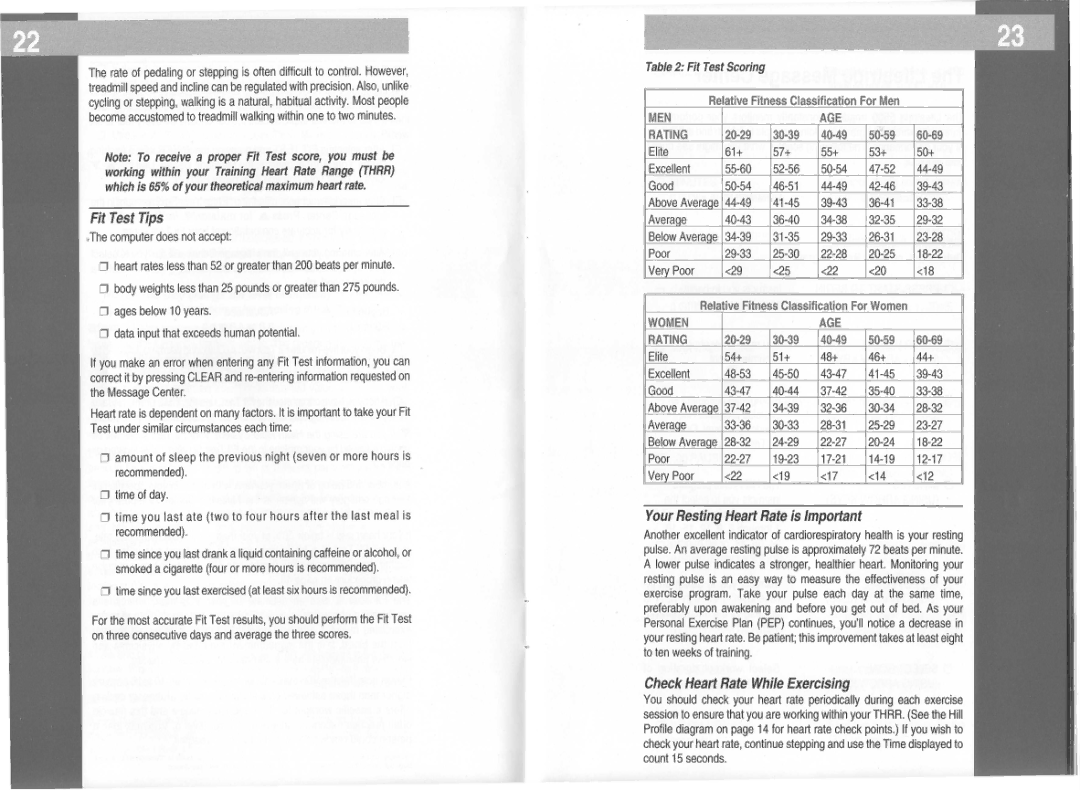
II
The rate of pedaling or stepping is often difficult to control. However, treadmill speed and incline can be regulated with precision. Also, unlike cycling or stepping, walking is a natural, habitual activity. Most people become accustomed to treadmill walking within one to two minutes.
Note: To receive a proper Fit Test score, you must be working within your Training Heart Rate Range (THRR) which is 65% of your theoretical maximum heart rate.
Fit Test Tips
.The computer does not accept:
Dheart rates less than 52 or greater than 200 beats per minute. D body weights less than 25 pounds or greater than 275 pounds. D ages below 10 years.
D data input that exceeds human potential.
If you make an error when entering any Fit Test information, you can correct it by pressing CLEAR and
the Message Center.
Heart rate is dependent on many factors. It is important to take your Fit Test under similar circumstances each time:
Damount of sleep the previous night (seven or more hours is recommended).
Dtimeof day.
D time you last ate (two to four hours after the last meal is
recommended) .
Dtime since you last drank a liquid containing caffeine or alcohol, or smoked a cigarette (four or more hours is recommended).
D time since you last exercised (at least six hours is recommended).
For the most accurate Fit Test results, you should perform the Fit Test
on three consecutive days and average the three scores.
Table 2: Fit Test Scoring
RelativeFitness ClassificationForMen
MEN |
|
| AGE |
|
|
RATING |
| ||||
Elite | 61+ | 57+ | 55+ | 53+ | 50+ |
Excellent | |||||
Good | |||||
Above Average | |||||
Averaae | |||||
Below Averaae | |||||
Poor | |||||
VeryPoor | <29 | <25 | <22 | <20 | <18 |
RelativeFitness ClassificationForWomen
WOMEN |
|
| AGE |
|
|
RATING | |||||
Elite | 54+ | 51+ | 48+ | 46+ | 44+ |
Excellent | |||||
Good | |||||
Above Averaae | |||||
~ge | |||||
Below Average | |||||
Poor | |||||
Very Poor | <22 | <19 | <17 | <14 | <12 |
Your Resting Heart Rate is Important
Another excellent indicator of cardiorespiratory health is your resting pulse. An average resting pulse is approximately 72 beats per minute. A lower pulse indicates a stronger, healthier heart. Monitoring your resting pulse is an easy way to measure the effectiveness of your exercise program. Take your pulse each day at the same time, preferably upon awakening and before you get out of bed. As your Personal Exercise Plan (PEP) continues, you'll notice a decrease in your resting heart rate. Be patient; this improvement takes at least eight to ten weeks of training.
Check Heart Rate While Exercising
You should check your heart rate periodically during each exercise session to ensure that you are working within your THRR. (See the Hill Profile diagram on page 14 for heart rate check points.) Ifyou wish to check your heart rate, continue stepping and use the Time displayed to count 15 seconds.
